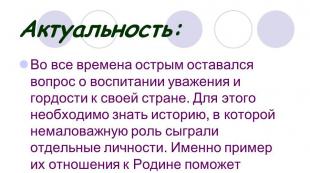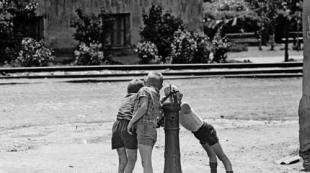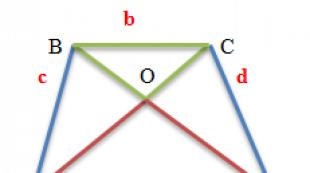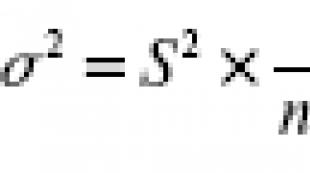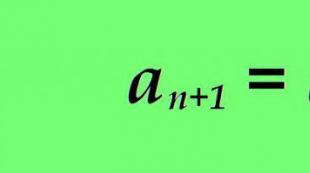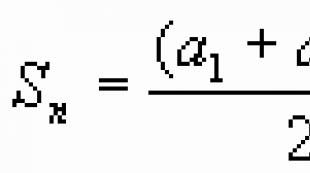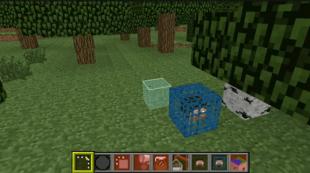Open lesson in teaching literacy on Umk "promising primary school"
DESIGNATION OF TWO SOUNDS [th ’], [o] ONE LETTER Yo
Goals: to acquaint students with the function of the letter "ё" to denote two sounds [y'o] in certain positions: at the beginning of a word and after vowels in a word; practice reading words with the letter "e"; to consolidate knowledge of the conventional designation of voiced, voiceless, hard and soft consonants; teach accented pronunciation of consonants based on single-level word models; form the ability to read sentences as relatively complete in meaning structural units; develop phonemic hearing and culture of sound pronunciation; cultivate love for animals.
Planned results:
Subject : to know and explain the function of the letter "ё" to denote two sounds at the beginning of a word and after vowels; perform syllabic and orthoepic reading of sound and letter schemes of a word.
Personal UUD
Regulatory UUD
Cognitive UUD
Communicative UUD
During the classes
I. Organizational moment.
Psychological attitude to work "I wish you good luck"
II. AOZ
Building a chainspeech - sentence - word - sound
Game "Vowel - consonant" Children with signal cards (blue - red) show which letter.
Work on the syllabic table.
III. Lesson topic message.
- Guess the riddle.
Here are the needles and pins
They crawl out from under the bench
They look at me
They want milk.(Hedgehog.)
- What letter do we write at the beginning of this word?
- Who guessed what the topic of our lesson? (letter E)
IV. Letters Ё ё
Let's open the tutorial on page 39.
Consider the letters Yoyo
Yo - take a look for yourself
Letter with dots-eyes.
Let's open the alphabet and find the letter ё.
What letter is above the letter Ё, below the letter Ё?
IV. Sound analysis of words based on two-level models
(p. 39).
Guys in the left corner, look at the models. What can we say about them?
The letter E does two things.
Let's define the goals of the lesson. ( Find out what work the letter ё does, what sounds it means, learn to read words with the letter Ё)
- Review the illustrations in the tutorial.
- Who is shown on the left?
- The fish is named "ruff" because of its spiny fins sticking out in different directions.
Hence the word "ruffled", that is, "prickly", "cocky".
Ruff and the brush were called - round, ruffy - for washing, for example, milk bottles.
- Read the word "ruff" by syllables and orthoepically.
- Where is the letter "e" in the word?
- How much is in a word sounds?
- How many letters are there in a word?
(The letter "ё" stands for two sounds - [y'o].)
(At the beginning of a word.)
- What is shown on the right?(Buyok).
A buoy is a signal float on a river to mark the boundary of something (for example, a sandbank, an area allowed for swimming.)
- Read the word"Buoy" in syllables and orthoepic.
- Explain what the word "beacon" means.
- Where in the wordis there the letter "e"? What letter is followed by the letter "e"?(After another vowel.)
- How many sounds are there in a word?
- How many letters are there in a word?
- What letter stands for two sounds?(The letter "ё" denotes two sounds - [y'o] - after another vowel.)
- When does the letter "ё" mean two sounds?(At the beginning of a word and after another vowel.)
Output:
The letter "ё" denotes two sounds [y ’], [o] at the beginning of a word, after another vowel.
Physical education
Vi. Exercise in reading syllables, words, sentences (p. 39).
Reading words and sentences.
Working with the proposal schema.
- Consider the illustration in the book. Who is drawn here?
- What is the girl doing?
- What is the boy doing?
- Analyze the model sentence schema in the textbook. How many words are in it?
- What can you say about the first word of the sentence?(This is a helper word.)
- Make suggestions for this scheme using the illustration in the book.
There are lemons on the table.
Masha has a shell.
Misha has a lot of lemons.
Physical education
Vii. Reading text.
1. Reading the text by reading children.
Hedgehog and brush
All the animals went to bed for the winter, and the hedgehogs lay down in a hole under the tree. And the little hedgehog cannot sleep.
- Mom! Why are we all asleep and asleep ... Can I go to my friend's brush?
- What are you? You will freeze still. Sleep!
The hedgehog lay, lay, fidgeted, waited until my mother fell asleep, and crawled out of the hole. I got out and was surprised. Everything is white and white, and the snow on the trees looks like a chicken, then like a hedgehog and even a brush!
- Oh, how great! And the brush is sitting in the river, he doesn't see anything of this!
I ran to the river, and instead of the river - one ice, and an ice-hole in the middle.
- Ruff, and Ruff! What have I seen! Well, ruff!
The hedgehog called for a long time, he froze all over. Finally, a sleepy ruff swam:
- Well, why are you shouting, you don't let me sleep?
- Are you sleeping too?
- And how. Until the very spring. Would you go too, huh?
The hedgehog trotted home, into a warm hole. I froze all over, ate honey so as not to get sick, and went to bed until spring.
G. Yudin
VIII. Lesson summary.
- Remember what goals you set at the beginning of the lesson? Have you reached them?
- What sounds does the letter "ё" mean?
- When does the letter "ё" mean two sounds?
Reflection "Fairy tree"
LETTER Ё - INDICATOR OF SOFTNESS
CONSISTENT SOUNDS. LETTERS Her
Goals: to reveal the function of the letter "ё" as an indicator of the softness of consonants; practice reading words with the letter "e"; learn to read words by syllables and orthoepic; to form the ability to read sentences as structural units that are relatively complete in meaning; develop phonemic hearing and culture of sound pronunciation; foster a culture of educational work.
Planned results:
Subject : know the way to indicate the softness of consonants using the letter "ё"; explain the function of the letter "ё" to denote two sounds at the beginning of a word and after vowels; perform syllabic and orthoepic reading of sound and letter schemes of a word.
Personal UUD : in the situations of communication and cooperation suggested by the teacher, make a choice of what to do.
Regulatory UUD: to distinguish between the way and the result of the action; acceptance of a practical task.
Cognitive UUD: use the simplest tables and diagrams to solve specific language problems; extract essential information from small readable texts.
Communicative UUD: convey your position to others; formalize your thought in oral speech; listen to and understand the speech of others.
During the classes
I. Organizational moment.
Psychological attitude to work "Smile"
II. Work on the syllabic table.
Let's read the vowels.
What vowels can represent two sounds?
What sounds does the letter "I" stand for? "e"?
Reading syllables.
III. Lesson topic message.
- What does a bear like the most?(Honey.)
- What does water turn into in winter?(Ice.)
- Analyze the words "honey" and "ice".
- After what letter is the letter "e"?(After a consonant.)
- Today in the lesson we will learn what role is played by the letter "ё" after a consonant.
Exercise in reading syllables (p. 40).put syllables on the board
- Compare the syllables in each column. How are they similar? What is the difference?
Name the vowels in the first column. What second job do these vowels do?
- How are consonants pronounced in the first column?(The consonants are solid.)
Let's read the syllables in the first column.
Now let's read the sound-letter model under these syllables. First, we read the sound scheme - model (stretching out sounds). We read the letter scheme of the word (by syllables, whole word).
Name the vowels in the second column. What second job do these vowels do?
- How are consonants pronounced in the second column?(Consonants are soft.)
Let's read the sound-letter model below. We read the sound model - we stretch out each sound.
Let's read the letter model by syllables, by the whole word.
- What sound does the letter "l" stand for?(A soft consonant sound.)
- Which vowel shows the softness of the previous consonant?
- What sound does the letter "ё" mean after a consonant?(Sound "o".)
What is the second job that the letter "e" does? What does it mean?
Output : the letter "ё" after the consonant denotes the sound [o and indicates that the preceding (preceding) consonant is soft.
Let's read the syllables in the second column.
Reading syllables:
mo but lo roma na la ra
my nyo le ryo me nya la rya
IV. Reading syllables and words from the textbook (p. 40).
After reading, students explain the meaning of the words.
Chalk - a lot of chalk.
The eagle is a large bird of prey. The eagle in a figurative sense is a symbol of strength, vigilance, foresight, nobility.
- Read the words that must always be capitalized.
Physical education
V. Reading sentences.
- Read the text in the tutorial.
- What did Lenya do?
- Who does Naum work for?
- What's your mom's name?
- Who has a nanny?
- What is the name of the nanny?
Physical education
Vii. Frontal work.
Reading from the board:
yer ate ryo le
yos yon syo nyo
- When does the letter "ё" mean one sound?
- When does the letter "ё" mean two sounds?
Game "Name the baby".
tiger - ... (tiger cub) elephant - ... (baby elephant)
goose - ... (gosling) lion - ... (lion cub)
elk - ... (calf) fox - ... (fox)
VIII. Lesson summary.
- what is the role of the letter "ё" in the word after the consonant?
- When does the letter "ё" mean two sounds?
Reflection "Traffic light"



 reading
reading
.
Theme : Letter Her at the beginning of a word and after a vowel
Goals:
-to acquaint with the vowel letter E, denoting 2 sounds at the beginning of a word and after a vowel;
- to form the reading skill with the letter E
Lesson Objectives:
- to form students' ability to read words with the letter E on the basis of their experience;
Promote the development of students' initial research skills; stimulate cognitive interest through problematic tasks;
- to educate observation, independence, the desire to become a literate person.
Equipment:
Textbook ABC, diagrams, pictures, toys
During the classes:
1. Organizational moment.
The lesson rang and fell silent
We begin our lesson.
We sat down at the desk together,
They looked at each other.
Wish success with your eyes
And forward, forward for knowledge.
For successful work in the lesson, remember the main rules of the student.
2 Updating basic knowledge.
Guys, before you are the letters that we studied. Divide the studied letters into 2 groups, depending on what sound they mean.
How can each group be divided?
Vowels - denoting the softness and hardness of consonants,
Consonants - voiced and voiceless
What letter is left? Why?
Where do we take it? (to vowels, indicates the softness of consonants)
How did you determine that this is a vowel sound? (pronounced freely, without meeting an obstacle in the mouth)
Can you identify the topic of our lesson?
Lesson topic: Letter E.
What tasks of the lesson will we set?
1. Find out what sound the letter stands for.
2. Find this letter and sound in a word.
Find:
E - [?]
[ ?]
3. "Discovery "of new knowledge.
Working with the tutorial page 43
Drawing of the letter E.
Name the letter all together. What sound did you hear? [Ye]
Say the first sound [th] What is it? (consonant, voiced, soft)
The second sound [e] is a vowel.
Find the letter E and Y on the tape of letters and paint over what sound they represent.
Look where the letter Y is. What are the names of these sounds? (sonorous, those are always sonorous)
Does the E always stand for two sounds? What sound can the letter E represent (uh, u)
Give examples.
Let's find out when the letter E stands for 2 sounds.
What conclusion can we draw?
E< [ Й’]
AT THE BEGINNING OF THE WORD
AFTER VOICE
Well done! What is the peculiarity of the new letter?(denotes (denotes 2 sounds if it is at the beginning of a word
And after the vowel)
4. Solving the rebus.
Can you guess it? How did you reason?
Unwashed in your mouth will never take
And you be so
How clean…. RACCOON
Who are raccoons? (fluffy animals)
Let's make a diagram of the word RACCOON(Pair work)
How many letters? How many sounds? Why?
5. Physical minute.
6. Play for attention. If there is a cunning letter E in the word, we clap our hands - salute this letter. If not, then we hide - we squat. Ready?
Egor, echo, ate, chalk, hedgehogs, river, spruce.
7. Anchoring. Group work.
Find in words the letter E, which denotes 2 sounds
E< [ Й’] снег
[Eh] we know
9. Lesson summary.
Which letter did you learn today?
What new have you learned about the letter?
What was interesting?
What is difficult? Well done! Thanks!
Municipal budgetary educational institution -
Lyceum No. 10 of the city of Belgorod
UMK "Perspective primary school"
1 class
Literacy training (writing)
Lowercase letter ё.
Prepared
primary school teacher
Sapega Olga Alekseevna
Belgorod,
Purpose of the lesson:
Primary assimilation of new knowledge and methods of action.
Lesson type:
The lesson of the primary presentation of new knowledge and methods of educational actions.
Planned results
Subject
The student will have the opportunity to learn:
writing a lowercase letter ё.
Cognitive
-
Self-identification and formulation of a cognitive goal.
-
Using various methods of searching and analyzing information in accordance with cognitive tasks.
- Mastering the logical actions of comparison, analysis, generalization.
- Execution of a task using material objects (pointers), pictures, diagrams, tables.
Regulatory
- To formulate and maintain the goal and objectives of educational activities, search for means of implementation.
- Develop motives for learning activities and form the personal meaning of learning.
- Assess the correctness of the choice of linguistic and non-linguistic means of oral communication in the lesson.
- Draw up a plan and sequence of actions.
- Control of own activities based on the results of the assignment.
Communicative
- Determine the overall goal and ways to achieve it.
- Interact (cooperate) with a neighbor on a desk, in a group.
- Seek help, formulate your difficulties.
- Build a statement that is understandable for listeners, ask clarifying questions, formulate simple conclusions.
- Observe the grammatical norms of speech.
Lesson number 45
Lesson topic: "The letter of the lowercase letter ё"
Target:To create conditions for the formation of the ability of students to write the lowercase letter ё.
Learning tasks:
1. To create a situation in which it becomes necessary to formulate a problem, to propose ways to solve it in order to obtain new knowledge.
2. To ensure the development of schoolchildren's ability to identify the key moments of their activities as part of the whole.
3. Create conditions for the development of students' ability to structure information.
4. To teach to control their activities in writing the lowercase letter ё, syllables and words with the letter ё.
Educational and methodological support
ABC: Notebook on the letter No. 2. Grade 1 / NG Agarkova, Yu. A. Agarkov. - 2nd ed., Rev. - M .: Akademkniga / Textbook, 2012.
- ABC. Teaching literacy and reading: Methodological manual / N. M. Lavrov. - Ed. 2nd, rev. - M .: Akademkniga / Textbook, 2011.
Envelopes with objects for construction (sound schemes, letter elements), colored pencils, bookmarks - stickers, information signs, assessment sheets.
During the classes:
I.
Organizational and motivational stage.
Target:
organize focused attention at the beginning of the lesson.
U .:- Check your readiness for the lesson.
(The student shows and tells how the workplace- the rest are checked.)
D .:- Notebook for writing, an envelope with elements of letters and sounds, pen, pencil, black felt-tip pen. Colored pencils: red, yellow, green, blue. Self-assessment sheet.
II. Goal setting.
Target:
to form children's ideas about what they learn new in the lesson, what they will learn.
U .:- Find the page on which we will work. What page is this?
D .:- Page 15.
U .:- Why do you think so?
D .:- In the last lesson we worked on page 14.
U .:- Look carefully at the page of the notebook. Together, try to define the topic of our lesson.
D .: -We believe that the topic of our lesson is: writing a lowercase letter ё, writing a small letter ё ...
U .: -What goals will you each set for yourself in order to learn how to write the lowercase letter ё?
D .: -We will find the elements that make up the letter ё, construct the letter, write it, draw up word schemes, complete the tasks of the Question of Voprosycha and Raskraskin.
The purpose of the lesson:learn to write the lowercase letter ё.
III... Primary perception and assimilation of new theoretical educational material.
Target:
1) Updating basic knowledge
1. Drawing up a lesson plan
U .:- Make a plan of work, based on the page of the notebook and the symbols.
(Children draw up a work plan using symbols.)
2) Recognition of the elements of the letter y.
U .:- What's the first step in the plan?
D.: - Construction of letters.
U .:- Look at the letter elements located in the upper right corner of the page. Analyze what elements the letter ё consists of. Paint over the circles you want.
U .: -Swap notebooks, check each other.
U .: -How many elements did it take?
D.: - Two.
U .: -Name the elements that make up the capital letter ё.
D.: - A strip in the form of a straight line; a strip in the form of a smooth line; oval-shaped strip (1, 3).
U .: -
3) Construction of the letter y.
U .: -What's the next step in designing the letter e?
D.: - Construction of letters.
U .: -How to check the correctness of the assignment for constructing a letter?
D.: - With the help of a "key" to the construction of written letters.
U .: -Elements with what numbers do we need? Where can we see this?
D.: - On page 32 of our notebook. (At the end of the notebook.) We need elements 35, 50 and 51.
U .: -Construct the letter ё. (Children complete the task.)
(Children complete the task. The teacher checks the letter on the desks.)
U .: -Rate your work on the grading sheets.
U .: -We add the elements of the letters. We remove the envelope.
3. Prepare your hands for writing.
1) "Lazy Eights"
2) Doing exercises for the hands.
At:- Prepare your hand for writing.
Children perform a set of exercises (circular movements of the hands to the left, to the right; exercises for fingers).
3) "Clothespin"(In your free hand from the letter, take a clothespin and massage (lightly pinch with a clothespin) each finger of the other hand, repeat 3 times).
4) Writing a lowercase letter ё.
W.
D .: -Writing a letter.
W.: - We continue our work. Take the pens. We write the elements and the letter ё in the air at the expense. We look at the board, repeat the writing of the letter after me. I'm on the board, you're on the air. Into the account: and - times - and - and - and.
W.: - Circle the letter y in the large rectangle with your finger.
W.: - Write the elements and the letter ё in a large rectangle under the count.
W.: - We write the letter ё on the first line under the account.
W.: - Where is the beginning of the letter?
D .: -Where the blue dot is.
W.: - Prepared to write with me at the expense. (1 line is dictated by the teacher and 2 students, one letter at a time, we count to ourselves to the end of the line.)
Dynamic pause
Target:change of activity
Exercise for the eyes.
1."The finger is doubled"(facilitates visual work at close range).
W.: - Stretch your hand forward, look at the fingertip of the outstretched hand located in the midline of the face, slowly bring your finger closer, without taking your eyes off it until the finger begins to double. Repeat 6-8 times.
2. "Keen eyes"
W.: - With your eyes, draw 6 circles clockwise and 6 circles counterclockwise.
3."Shooting with eyes"
W.: - Move your eyes from side to side, looking as far as possible to the left, then to the right, then up and down. Repeat 5-6 times slowly.
4."Letter by the nose"(reduces eye strain).
W.: - Close your eyes. Using your nose as a long pen, write the letter ё.
IV. Application of theoretical positions in the conditions of performing exercises and solving US.
Target:formation of the way of activity.
1. Exercise in writing connections: le, nyo, ryo- middle connection.
W.: - What is written on the second line?
D .: - Syllables.
W.: - How many syllables?
D .:- Three.
W.
D .:- They have two letters, the second letter is e.
W.: - We write at the expense.
2. Exercise in writing connections: er- top connection, eh, ate- bottom connection.
W.: - What is written on the third line?
D .: - Syllables.
W.: - How many syllables?
D .:- Three.
W.: - Let's read the syllables. What do they have in common?
D .:- They have two letters, starting with the letter ё.
W.: - What secret of the letter ё did we meet in the reading lesson?
W.: - Guys, find a hint on the notebook page.
D .:- The letter ё can mean two sounds if it is at the beginning of a word or in the middle after a vowel.
W.: - What is the difference in the spelling of syllables?
D .:- Different types of connections.
W.: - We write at the expense.
Dynamic pause
Target:
change of activity
"Brain gymnastics"
(a set of exercises aimed at improving brain activity ).
1.
"Head shaking"
(exercise stimulates thought processes).
W.- We got up, put our feet shoulder-width apart. Let's straighten our shoulders. We breathe deeply. Inhale, exhale. Drop your head forward and let your head swing slowly from side to side as the tension goes away with the breath. The chin traces a slightly curved line across the chest as the neck relaxes. (30 seconds).
2.
"Hat for Reflections"
(at improves attention, clarity of perception and speech).
W.- "Put on your hat", i.e. roll your ears gently from the top point to the lobe (three times).
VI... Independent, creative use of formed skills and abilities.
Target:
develop independence, creativity of students.
1.
Drawing up sound-letter schemes for words
.
W.
D .:- Working with sound-letter word models.
W.: - This is a very difficult task, you may even have to do some research. Listen carefully to the briefing.
1)
Read the sound-letter model of the word.
2)
Break the word into syllables.
3)
Think about which word from workbook this scheme is suitable.
4)
Recode the sound model to sound.
5)
Designate sounds with block letters.
6)
Designate sounds in capital letters.
W.: - We work in threes. Distribute responsibilities. (Choose a captain. One - records sounds, the other - types letters, the third - recodes block letters into capitals. We work with a black felt-tip pen. The captain helps to assign responsibilities.)
W.: - Consider the table, select a word from a notebook for this model.
(mine, mine, mine)
Ó
W.: - Who managed to find a word for this model?
W.: - Who could not find a word for this model? The guys will help you by telling you how they worked.
2. Presentation of completed works.
W.: - One person from the group will come to the board and tell how their group worked.
D .:- We consulted and decided that my word would be suitable for the scheme, because the letter ё stands in the middle of the word after the vowel and denotes two sounds [yo]. Lera wrote sounds, Artyom typed letters, and Pasha wrote down capital letters.
U .: -Rate your work on the grading sheets.
3.
Writing words according to the pattern in notebooks.
Word cheating rules.
W.: - Let's remember the rules for copying words.
D .:- It is necessary to read the word by syllable. It is necessary to pay attention to the types of compounds in the word.
1)W.: - Read the first couple of words again. How many syllables are there?
D .:- In my word one syllable, and in my word two.
W.: - Pay attention to the types of compounds in words.
W.
2) W.: - Read the second couple of words again. How many syllables are there?
D .:- In my word one syllable, and in my word two.
W.: - Pay attention to the types of compounds in the word.
W.: - Write the words, dictating to yourself by syllables.
4) Self-test. (Children read what is written, put stress, mark syllables with arcs.)
W.: - Check the spelling of the words. Read the word, put the stress, mark the syllables with arcs.
4. Execution of logical tasks with letters.
W.: - What's the next step in the plan?
D .:- We will carry out tasks Question Voprosycha.
W.: - What question did the Question Voprosych want to ask us? How many requirements are in this assignment?
D .:- Three requirements. Find a common element in letters, compare letters, recode letters.
W.: - Right. And you will perform it in fours.
U .:- Remember the rules for working in groups. (The rules are pinned on the board)
Group rules
:
1.
Speak in a low voice. Do not scream!
2.
Share your opinion.
3.
Give each friend in the group an opportunity to speak. Cooperate, respect all members of the group.
4.
Choose a consultant.
W.: - Analyze the letters a, y, y, s, i, I.Why are letters written after the arrow from a circle with letter elements on the working linea, y, y, s, i, I.
D .: -
W.: - Analyze the letters me, me, oh, oh, (yo), ah. Highlight a common element in them and think about which element you need to fit into the circle.
D .: -You need to inscribe an oval-shaped strip in the circle, because it is a common element of letters me, me, oh, oh, (yo), ah.
W.: - Why was the letter ё written in brackets?
D .: -Because the letter e no oval stripe element.
5.
Writing proposals based on the pattern in notebooks.
W.: - What is written on the last line?
D .: -The last line contains a sentence.
D .: -Read it.
D .: -My name is Lenya.
W.: - How many words are there in a sentence?
D .: - Three.
W.: - Explain the rules for writing a sentence.
W.: - Why the word Lyonya written with a capital letter?
D .: -This is a proper name.
W.: - Write a sentence, dictating to yourself by syllables.
6. Drawing the border pattern
U .:- What's the next step in the plan?
D .:- We will carry out the tasks of Raskraskin.
U .:- What tasks did Raskraskin offer us?
D .:- Determine which elements of the written letters are "hidden" in this pattern. (Loop-shaped strip.) Continue the pattern to the end of the page. Colorize.
Vii... Reflection of activity. Lesson summary
1.
Correlation of purpose and result of activity
W.: - What's the next step in the plan?
D .:- The result of the work.
W.: – What new did you learn in the lesson? (What discoveries did you make in the lesson?)
W.: – Have you achieved your goals?
W.: – What steps have been taken to achieve the goals?
D .:- We found the elements that make up the letter ё, designed the letter ё, wrote it, made word schemes, completed the tasks of the Question of Voprosycha and Raskraskin.
W.: – What are the results?
D .:- We learned to write the lowercase letter ё.
W.: - Evaluate your work in the lesson in the assessment sheets.
MCOU "Secondary School No. 14"
Art. Novotroitskaya
Izobilnensky district
Stavropol region
Sazonova Lyubov Nikolaevna
Writing lesson in grade 1
UMK "Perspective primary school"
Subject: Capital letter "E"
Goals: to form in the memory of students a clearly differentiated visual-motor image of the capital letter "E"; continue the formation of skills to analyze words perceived by ear, correlate them with schemes and models; learn to recode the sound-phonemic form of a word into an alphabetic one and vice versa; improve the ability to perform types of connections of letters in a word (upper, medium, lower); develop memory, attention, speech skills, the ability to analyze and generalize.
Equipment: interactive whiteboard, notebook, letter table, customized envelopes with letter element templates.
During the classes
I. Organizational moment.II. Lesson topic message.
The teacher conducts the game "Speak a word".
... The berry tastes good
But rip it off, come on:
A bush with thorns like a hedgehog
That's named ... (blackberry).
... Unwashed in the mouth
Won't take it for anything.
And you be so
How clean ... (raccoon).
... You will read this tale
Quiet, quiet, quiet ...
Once upon a time there was a gray hedgehog
And his ... (hedgehog).
- What unites all the answer words?
- With what sound do these words begin? (From the sounds [th ’] [eh].)
- Today in the lesson we will learn to write and connect with other letters the capital letter "E", which denotes the first word in a sentence and proper names.
III. Repetition of what was learned about the role of the letter "e" in words.
- Remember the names of people that start with the letter "E". (Egor, Emelya, Erema, Elena.)
- What sounds does the letter "e" mean at the beginning of a word? (Sounds [th ’] [uh].)
- In what words does the letter "e" mean one sound? (After a consonant.)
IV. Formation of the visual image of the capital letter "E" in the memory of students.
The teacher demonstrates a table of four forms of the letter "E": small and large printed, lowercase and uppercase written.
- Compare the capitalized and capitalized letters "E".
- How are they similar? What is the difference?
Next, the teacher constructs the capital letter "E" on the magnetic board.
- Name the elements that make up the capital letter "E". (Two stripes in the shape of a semi-oval.)
- Consider the elements of the written letters given in the notebook, and circle only those that make up the capital letter "E".
- Construct the capital "E" on your desk.
In individual envelopes, in addition to templates No. 24 and No. 23, necessary for the construction of this letter, you should put templates No. 16, No. 18, No. 21, No. 19 to differentiate the size and shape of the elements.
- Check the correctness of the task of constructing the letter using the "key". (Book number 2, p. 32.)
V. Formation of the visual-motor image of the letter in the memory of students.
1. The teacher gives first a complete and then a short explanation of the pattern of the capital letter "E" on the blackboard with chalk.
2. Show and explanation by the teacher on the blackboard of the technology of drawing the capital letter "E" under the count.
3. Students perform the exercise in a rhythmic alternation of muscle tension and relaxation, counting first "in the air", and then counting on a notebook (p. 31).
4. Pupils' imitation of drawing according to an algorithm based on motor elements that are sequentially connected in a letter (a letter in a blue frame).
Preparing your hands for writing.
Vi. A letter to students in a notebook.
- Take the correct posture for writing and observe it during the execution of the task of one line.
If necessary, the teacher provides individual assistance to students.
1. Writing by students in a notebook of motor elements, their complexes and the capital letter "E" according to the algorithm.
2. Exercise in writing connections:
a) upper connection: Ey;
b) medium-melting: Her;
c) lower: Eo.
F i z k u l t m and n u t k a
Vii. Writing words by pattern.
Students read words.
- Why should these words be written with a capital letter?
- Analyze each word and make sound-letter schemes.
After analyzing the connection of letters, the students write down the words according to the pattern.
VIII. Performing logic tasks with letters.
- What letters did Pochemuchka write down?
- Compare the letters e - E. How are they similar? What is the difference? (In these letters, an element of the same shape is a strip in the form of a semi-oval.)
- Compare the letters E - R. How are they similar? What is the difference?
- Compare the letters E - E. How are they similar? What is the difference?
IX. Drawing a border pattern.
Students complete the pattern.
- What elements of written letters are "hidden" in this pattern? (Semi-oval stripes.)
- Guess the riddle:
... Sleeping flower
And suddenly I woke up
I didn't want to sleep anymore,
Moved, roused,
Soared up and flew away.
(Butterfly.)
- Color the butterfly in the pattern.
X. Lesson summary.
Sections: Primary School
Lesson: literacy training.
Lesson type: study and primary consolidation of new knowledge.
Lesson topic:"Consonant deaf sounds [t] [t '], differing in terms of softness-hardness."
Lesson objectives:
1. To acquaint students with voiceless consonant sounds [t] [t ’] and the letter denoting these sounds, to teach to differentiate these sounds by hardness - softness; to train students in reading syllables, words and text.
2. To develop phonemic hearing, culture of sound pronunciation, speech, attention, memory, thinking.
3. To foster a culture of educational work.
During the classes
I. Organizational moment
II. Sound analysis of words
D: Guys, listen carefully and guess which word is hidden:
1. A large, usually dark, thick cloud, carrying rain, sleep.r (Cloud)
2. A mobile ladder for getting off the plane and landing. (Ladder)
3. Armored self-propelled vehicle on a tracked chassis with powerful weapons. (Tank)
4. Trace from touching the tip of a pencil, pen; small round speck. (Point)
5. Something hidden from others, not known to everyone, a secret. (Secret)
D: Repeat all the words that you guessed. (One of the students voices)
D: What have you noticed?
D: All words begin with the sound [t]
D: Put your fingers to the larynx and say all together this sound
D: [t] - [t] - [t] - [t]
W: Describe this sound.
D: This sound is a voiceless solid consonant.
D: A consonant deaf solid sound will be denoted using the scheme -
D: Guys, the name of one of the clowns begins with this sound.
(There are two pictures of clowns on the board, under which are the sound schemes of words)

D: His name is Tom.
D: Say the name of this clown, emphasizing each sound with your voice.
D: What's the name of the second clown?
D: His name is Tim. The first sound is indicated by a square and an apostrophe, which means this sound is soft.
D: Check it out? Say the name of this clown, emphasizing each sound with your voice.
D: [t ’] [and] [m]
D: Put your fingers to the larynx, say all together the first sound.
D: [t ’] [t’] [t ’] [t’]
W: Describe this sound.
D: This sound is a voiceless, soft consonant.
D: A consonant dull soft sound will be denoted using the scheme -
The sounds [t] [t ’] stands for the letter“ t ”(showing the letter).
Fizminutka
III. Construction of the block letter "T" "t"
D: Guys, open the envelopes, from the elements of block letters construct a capital letter "T" and a lowercase letter - "t"
Students are doing work.
W: So what elements did you choose?
D: For the capital letter “T” we select the elements - №1 (vertical line) and №5 (horizontal line), for the lowercase - №5 (vertical line) and №9 (horizontal line)
IV. Acquaintance with the designation of the studied sounds using a printed lowercase letter "t" in square brackets
W: Guys, what did you find out about the letter "t"?
D: The letter "t" denotes a hard consonant [t] and a soft consonant [t ’].
U: The sound [t] is denoted with square brackets and a lower case letter “t” (showing the card), and the sound [t ’]….
D:… using square brackets, a lowercase “t” and an apostrophe.
D: Name the words that begin with the sound [t]
D: Taxi, tundra, dachshund, dance, cloth….
D: Name the words that have the sound [t ’]
D: Tyr, tina, kitten, aunt, boots ...
V. Comparison of sound and letter forms of words based on a two-level model
 |
 |
||||||||||||||||
|
|
D: Open the “ABC” on page 49. Look at these diagrams. Say the word for the item on the left, emphasizing each sound with your voice.
D: [t ’] [o] [p] [n] -" turn "(orthoepic reading)
W: Guys, explain the meaning of the word "turn".
D: Thorn - a thorny bush (with tart bluish-black fruits)
D: Say the word that denotes the name of the object on the right, emphasizing each sound with your voice.
D: [t] [o] [p] [t] - "cake" (orthoepic reading)
W: Guys, explain the meaning of the word "cake".
D: Cake is a sweet pastry made from pastry with cream.
W: How are these schemes similar?
D: - These words have one syllable, since there is one vowel sound.
Vowel sound [o]
In these words, the number of sounds and letters is the same - 4 sounds and 4 letters
The first letter is "t", the third letter is "p". These letters represent solid consonants.
W: How are these schemes different?
D: - In the first word the last letter "n", in the second - the letter "t"
In the first word, the letter "t" means [t ’], and in the second word - [t]
In the first word, the sound [o] denotes the letter "ё", and in the second - the sound [o] denotes the letter "o"
Conclusion: the letter "ё" indicates that the preceding letter "t" denotes a soft consonant sound, and the letter "o" indicates that the letter "t" denotes a hard consonant sound.
Vi. Reading syllables according to the given schemes

D: In which column does the vowel indicate that the previous letter denotes a solid consonant sound?
D: In the second column (students read syllables aloud)
D: In what other column does a consonant letter denote a solid sound?
D: In the first, because the letter "t" "closes" the syllable (students read open closed syllables)
D: What sound does the letter “t” in the third column represent?
D: Soft consonant sound, because after the letter "t" there are vowels ("I", "u", "ё", "e", "and"), which indicate the softness of the previous consonant.
Physical minute.
Vii. Reading syllables and words in a column

D: Going to page 50. I suggest you read the wordstring data.
Students read the words in a chain, first in a chant, by syllables, and then - taking into account the stressed syllable, that is, orthoepically, clarifying the lexical meaning of incomprehensible words. (In the second line, “word-noun” is transformed into “word-adjective” - mint - mint, so after the adjective there is a rectangle as a symbol of the word for which you need to choose “word-object”, for example, mint - mint candy)
After reading, the teacher offers to complete the following task:
D: Read words in which the letter “t” only denotes a soft consonant sound.
D: "utya," because after the letter "t" there is the letter "I", which indicates the softness of the previous consonant
D: "methyl", because after the letter "t" there is the letter "i", which indicates the softness of the previous consonant
W: In what words does the letter "t" mean both a soft consonant sound and a hard one?
D: "noted", "ducklings"
D: Well done!
VIII. Reading text
D: A whirlpool is a deep hole at the bottom of a river or lake.
Summer morning. Little ducklings near a dark pool. He conceals many secrets. That's what pulls the ducklings to dive. Dive, dive, dive! And there is silt, dregs and secrets.
Everyone reads with a humming reading, then one student reads.
D: Find and read a sentence that explains why the ducklings ended up in a dark pool.
D: He hides a lot of secrets
D: What did the ducklings see in the pool?
Students find the answer to this question in the text, then read
D: And there is silt, dregs and secrets.
D: If there was no secret in the pool, then maybe the ducklings shouldn't have dived?
D: They were interested to know what was in the pool. They are small and curious. If the ducklings had not dived, they would not have known what was there.
W: Of course, everyone can discover new things for themselves, if they are not afraid to take a step forward into the unknown.
IX. Lesson summary
W: What have you learned new for yourself?
D: The letter "t" denotes a consonant voiceless hard sound [t] and soft [t ’]
The meanings of new words.
W: Thanks for the lesson.
